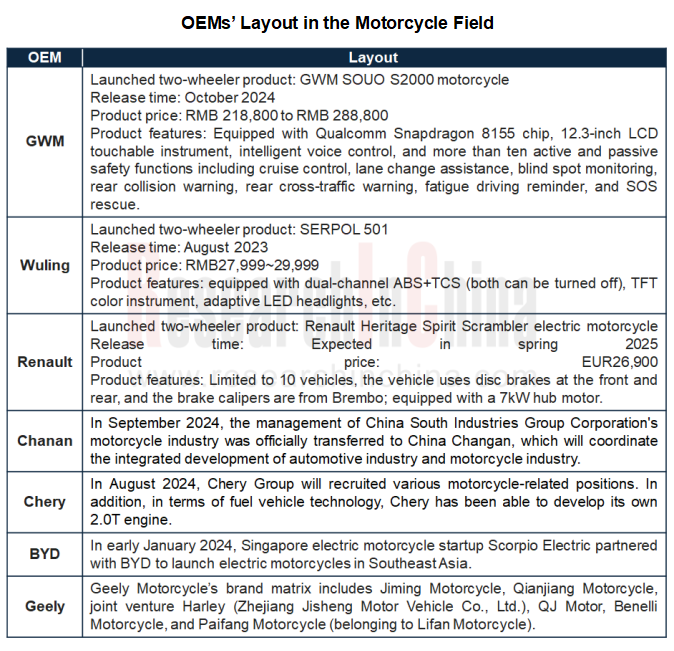Two-wheeler Intelligence and Industry Chain Research Report, 2024-2025
Research on the two-wheeler intelligence: OEMs flock to enter the market, and the two-wheeler intelligence continues to improve
This report focuses on the upgrade of two-wheeler intelligence, analyzes and studies the market size, intelligent functional characteristics, industrial chain of intelligent components, overseas markets, competition landscape, manufacturers' intelligent strategies, and development trends of electric two-wheelers and motorcycles. The main research scope includes:
1) Market overview of two-wheelers: production and sales volume, competition landscape, industry policies, etc. of electric two-wheelers and motorcycles;
2) Overseas trends of two-wheelers: the global market size of two-wheelers and the characteristics of two-wheelers market in China, Europe, USA, and Southeast Asia, and the layout of Chinese manufacturers in various regions overseas;
3) Intelligent strategies of electric two-wheelers and motorcycle manufacturers;
4) Research on the intelligent industrial chain of two-wheelers;
5) The intelligent development trends of two-wheelers in power system, intelligent driving, communication system, HMI, etc.
1. Electric bicycles: Automotive-grade radar is installed to enable intelligent driving functions
With rapid development of science and technology, electric bicycle field is experiencing a revolution, and is becoming more and more intelligent. Intelligent electric bicycles are no longer just a simple means of transportation, but a mobility partner that integrates various advanced technologies.
In 2024, a number of new policies were introduced, involving intelligent configurations such as intelligent connectivity and battery management for electric bicycles. Among them:
On December 31, 2024, the mandatory national standard "Safety Technical Specification for Electric Bicycle" revised by the Ministry of Industry and Information Technology and other five departments, was officially released. The new national standard stipulates that electric bicycles must have Beidou positioning, communication and dynamic safety monitoring functions, and will be implemented on September 1, 2025.
The mandatory national standard "Safety Technical Specification of Lithium-ion Battery for Electric Bicycle" (GB 43854-2024), implemented on November 1, 2024, stipulates the safety requirements and test methods applicable to lithium batteries for electric bicycles from two levels: single cells and battery packs, providing a standard basis for battery safety management in the intelligent configuration of electric bicycles.
In May 2024, the Shenzhen Electric Bicycle Industry Association issued the "2024 General Technical Specifications for Intelligent Battery-swapping Electric Bicycle" (Draft for Comments). This group standard specifies the terms and definitions, general requirements, functional requirements and test methods for intelligent battery-swapping electric bicycles. It regulates intelligent functions of intelligent battery-swapping electric bicycles, such as network communication, remote upgrade, positioning, alarm, and remote control.
In terms of intelligent connectivity, well-known manufacturers such as Yadea, Aima, Segway-Ninebot, Niu Technologies, TAILG, and SUNRA have equipped their smart models with brand-exclusive APPs. Taking Niu Technologies as an example, its smart APP has functions such as IVI interconnection, vehicle control, real-time positioning, and key sharing.
In terms of battery management, Niu Technologies's self-developed intelligent BMS cloud manager uses years of battery management big data combined with different driving habits and optimizes SOC algorithm through AI to analyze the battery's voltage, current, temperature and other conditions, ensuring accurate estimation of battery's remaining power in multiple scenarios. Combined with the Niu Technologies smart APP, it can achieve 24-hour monitoring of the battery status.
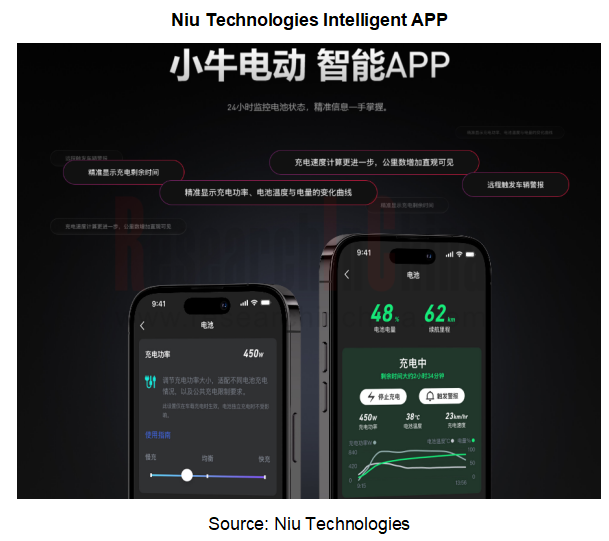
All Segway-Ninebot electric vehicles on sale are equipped with its own BMS6.0 system, which monitors the battery discharge status 24 hours a day, and performs intelligent management and protection, extending the battery life. Users can view and manage the functions of BMS 6.0 system in the Segway-Ninebot APP, and can also set some battery usage habits in the App. In daily actual use, when the lithium battery is too low or charging is completed, the App will have responsive reminders and notifications.
In addition to intelligent connectivity and battery management, the application of inertial measurement units, radars, and high-computing power chips in electric bicycles are also particularly noteworthy.
In July 2024, DJI launched the Avinox electric power assist system, which is equipped with an inertial measurement unit (IMU) and wheel speed sensors, and can provide multiple assistance methods such as push assist, Auto Hold, hill start assist, and on-the-spot gear shifting. In any riding mode, long press the button with left dial arrow pointing down to turn on the power assist function.
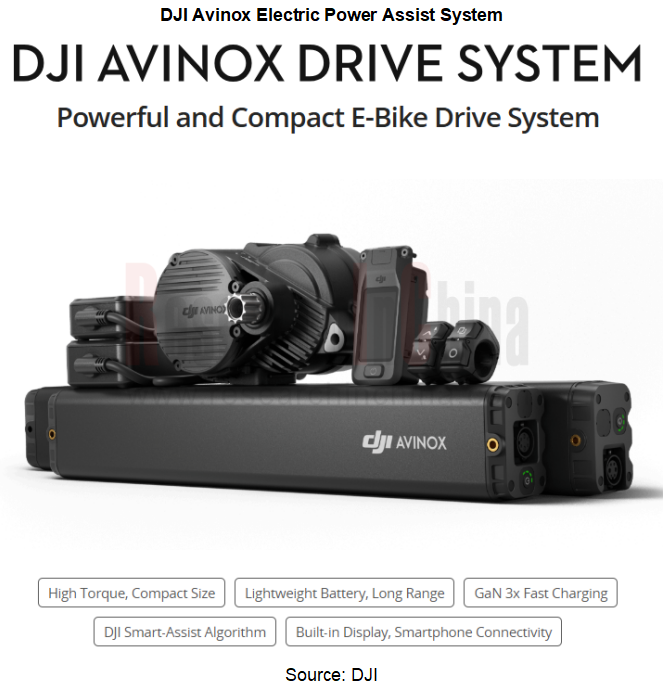
The NXT electric bicycle released by Niu Technologies in February 2024 is priced from 6,299 yuan. It is equipped with automotive-grade radar, BSD system, and RCW system. It can automatically identify the vehicle distance and predict oncoming vehicles from the side and rear. It is equipped with an automotive-grade driving recorder to form all-round driving protection from riding warning to later stages, effectively avoiding accidents.
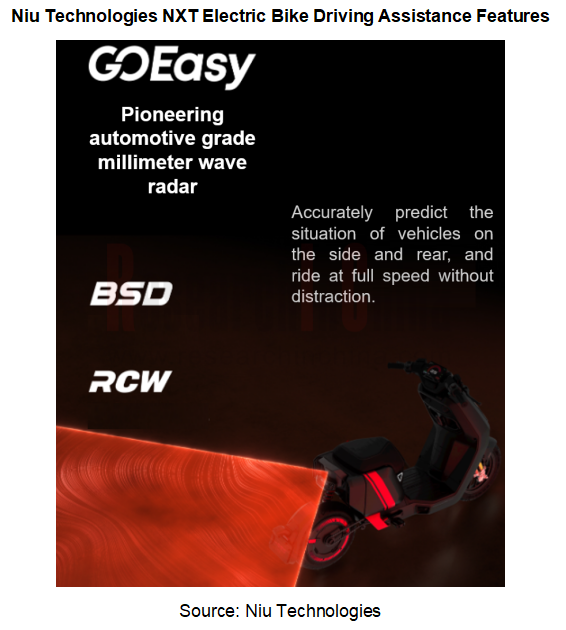
In January 2025, Segway-Ninebot launched Ninebot SIGHT (Ninebot AI Visual Assist System), which uses three high-performance AI chips in its cameras. Combined with powerful computing power of 2.4TOPS, it not only provides 2K high-definition driving record function, but also integrates intelligent warning capabilities such as forward collision warning, blind spot monitoring, and lane departure warning. In addition, Ninebot SIGHT also supports AI gesture recognition and cloud intercommunication, and realizes emergency recording, remote monitoring and other functions through the App.
2. Motorcycles: Introducing AI to inject soul into the IVI
There is no finalized intelligent classification standard for electric bicycles. As for the motorcycle market, on September 27, 2024, the China Electronics Chamber of Commerce issued the world's first two-wheeler intelligence classification group standard - "Riding Intelligence Classification of Motorcycles and Mopeds" (Standard No. T/CECC 028-2024), which came into effect on November 1, 2024, and the implementation objects include motorcycles and mopeds.
The standard divides riding intelligence into six levels: L0\L1\L1P\L2\L2P\L2U, and judges intelligence from eight aspects: communication system, interaction system, perception system, positioning system, attitude system, cloud platform, assisted driving domain controller, and vehicle control system. The standard has been piloted in Yadea, Dachangjiang, CFMOTO, and Keeway, aiming to launch the world's first two-wheeler model with an intelligent classification mark in early 2025.
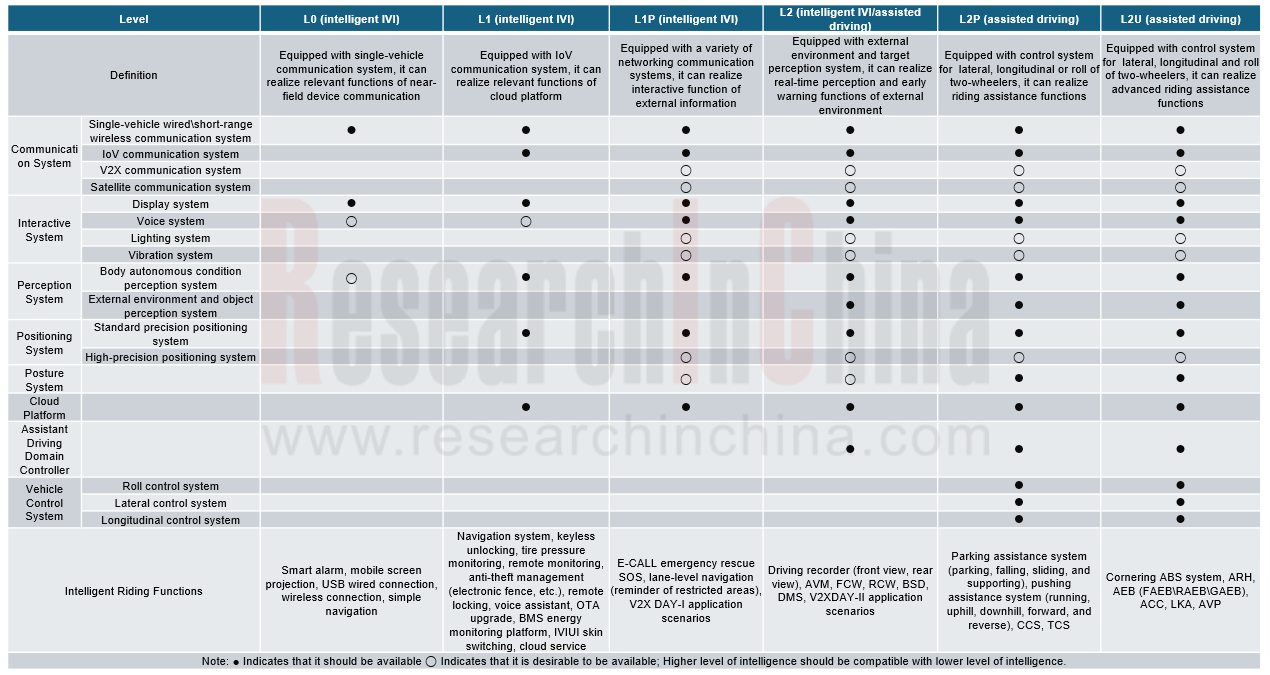
From the perspective of motorcycle market, Chinese market demand slows down in 2024, but the market for large-displacement leisure and entertainment motorcycles will be hot, and intelligence will become a new development direction.
In terms of artificial intelligence, motorcycle companies have introduced AI technology into IVI to achieve voice interaction and even emotional interaction, taking the HMI experience to a higher level. Among them, QJMOTOR, Kawasaki, Yadea and others are equipped with AI voice assistants, which can provide a wealth of vehicle control functions.
In January 2024, QJMOTOR released the ParaPal intelligent architecture, which introduced AI voice interaction through powerful hardware computing power and dedicated cloud algorithms and big data models, and can realize functions such as voice recognition, human-machine collaboration, and AI navigation. Through "Xiao Q Xiao Q", users can communicate with QJMOTOR's vehicle through a microphone when parking, and can talk to the vehicle through Bluetooth headphones when riding, and complete navigation settings, light switches, windshield up and down, etc. by voice. In addition, the vehicle can also perform real-time blind spot detection, and urge users to wear helmets before starting the vehicle through facial recognition cameras.
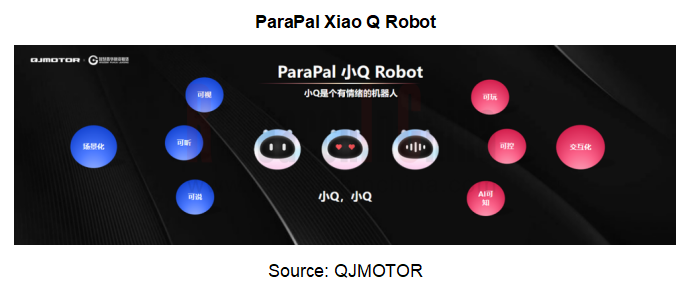
In November 2024, Kawasaki and Cerence reached a cooperation agreement. Kawasaki will integrate Cerence Ride platform designed for two-wheelers. Using this platform, riders can access navigation, vehicle control and cloud applications through AI voice assistants. The Cerence Ride two-wheeler platform is compatible with Android and iOS systems and can be embedded in smartphones and vehicle dashboards. It provides pre-integrated voice AI software development kit (SDK) and service support. In addition, Yadea also uses Cerence's AI voice technology.
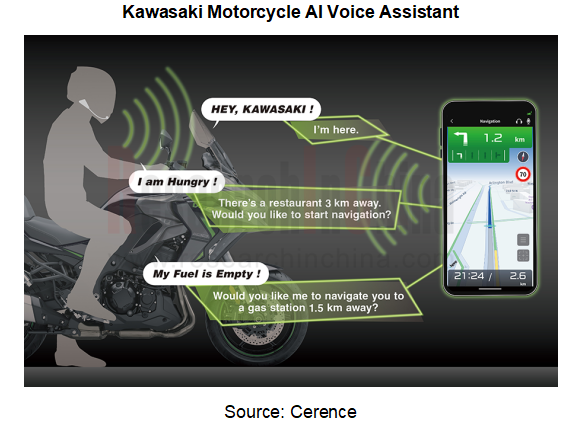
Besides voice interaction, AI's concept of emotional interaction has given motorcycles a new lease of life. Yamaha has launched the AI-enable MOTOROiD 2 (concept car). The MOTOROiD 2 incorporates advanced AI technology and can achieve autonomous driving and intelligent interaction by sensing the rider's movements and intentions. Specifically:
Facial recognition and gesture control: Equipped with AI system, it has facial recognition and gesture control functions. The rider can control the vehicle's start, stop, follow movement, etc. through facial expressions and gestures.
Emotional interactive experience: Identify riders’ instructions and automatically adjust driving performance based on their movements and emotions. For example, riders’ facial expressions are captured by smart cameras to determine their emotional state, and then adjust parameters such as vehicle speed and suspension hardness.
Full range of interactive interfaces: Most of vehicle exterior components can be used as interactive interfaces to interact with the rider. The “leaf” structure can communicate with the rider through tactile feedback, allowing the rider to feel vehicle’s status and intent.
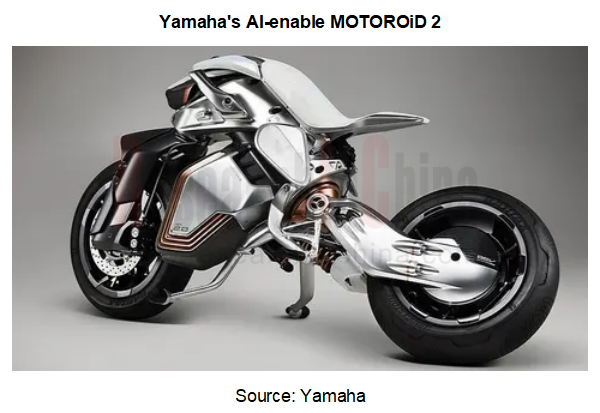
In terms of driving assistance, in September 2024, Bosch launched a new generation of radar-based rider assistance system, which includes six major functions: Adaptive Cruise Control Stop & Go (ACC S&G), Group Ride Assist (GRA), Rider Distance Assist (RDA), Emergency Brake Assist (EBA), Rear Distance Warning (RDW), Rear Collision Warning (RCW).
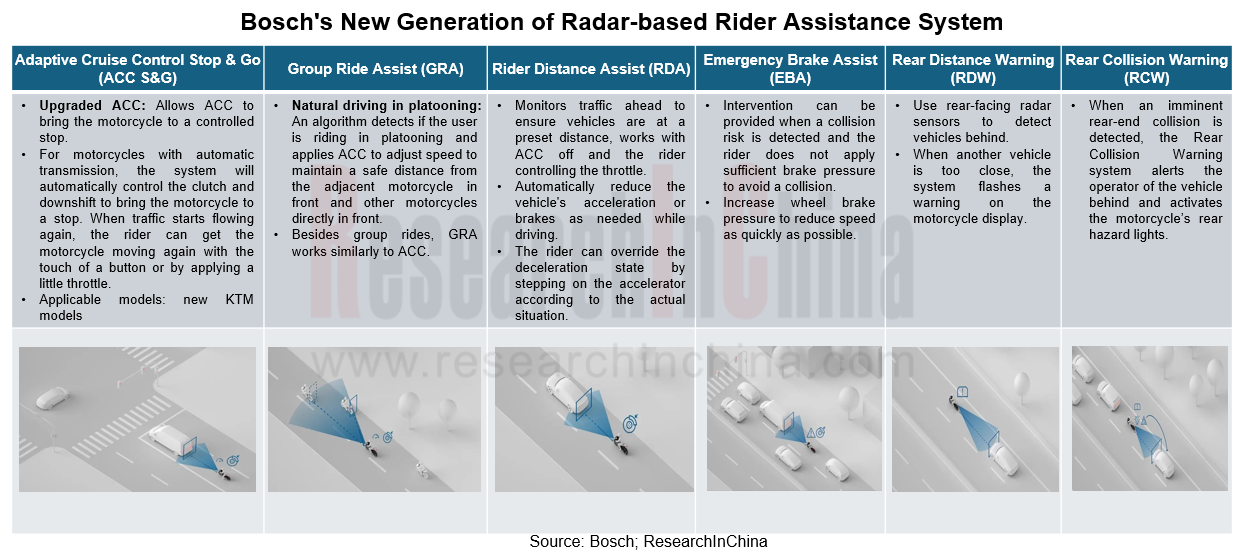
3. OEMs cross over into the high-end two-wheelers market
In recent years, a number of OEMs have entered the motorcycle industry. Among them, Wuling and Great Wall Motors have officially launched new motorcycle brands and entered the market with a high starting point.
In October 2024, the motorcycle SOUO S2000 launched by Great Wall Motors was officially launched, with a starting price of 218,800 yuan. SOUO S2000 is equipped with a world-first horizontally opposed eight-cylinder four-stroke water-cooled engine and a global-first 8-speed DCT automatic transmission (8* forward gear + reverse gear), which is full of power. In terms of braking, it is equipped with Brembo's opposed four-piston calipers, combined with the vehicle's straight /curved ABS, TCS and IMU six-axis sensor (which can monitor the vehicle's posture in real time and accurately control it), providing the vehicle with safe and stable braking performance.
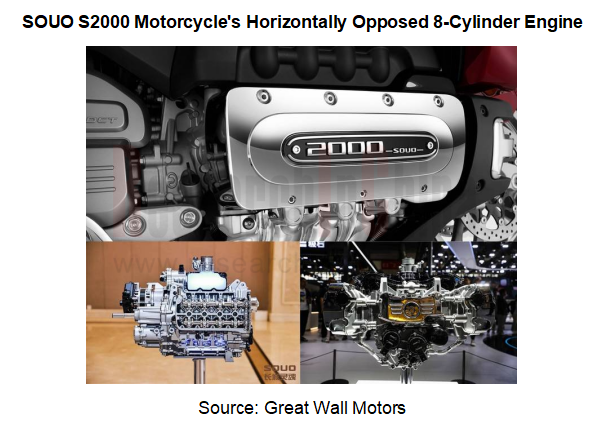
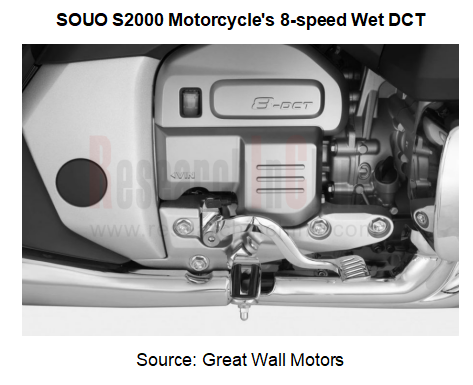
In terms of intelligent driving, GWM SOUO S2000 introduces a large number of automotive-grade electronic safety measures, such as fatigue driving reminder, tire pressure monitoring, hill assist, electronic handbrake, etc. as standard. In addition to the hatchback version, the other two versions even add a series of electronic auxiliary safety measures to ensure driving safety, such as lane change assistance, blind spot monitoring (equipped with radar), rear collision warning, rear crossing warning, SOS rescue, etc.
As for intelligent cockpit, based on the software and hardware architecture of Great Wall Motors' automotive-grade intelligent cockpit, GWM SOUO has made exclusive adaptation and optimization for motorcycle products to create GWM SOUO motorcycle intelligent cockpit architecture. The vehicle is equipped with Qualcomm Snapdragon 8155 chip, with a 12.3-inch LCD touch instrument and intelligent voice control function, realizing an interactive experience of "touchable when still, talkable when moving, smarter and more comprehensive" in riding scenarios.
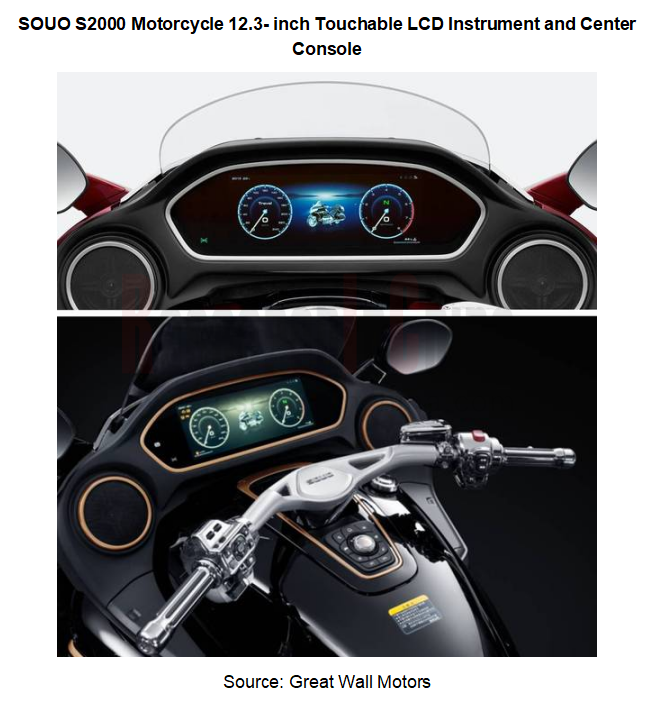
In addition to GWM, Wuling, Chery, Changan, BYD and Geely also have corresponding layouts in the motorcycle field.
In September 2024, China South Industries Group Corporation held a special meeting on professional management of motorcycle industry at the China Changan headquarters, announcing that the management of motorcycle industry would be formally transferred to China Changan. Chen Wei, President and Deputy Secretary of the Party Committee of China Changan, said that China Changan will make every effort to enable the coordinated integrated development of automotive industry and motorcycle industry.
In August 2024, Chery Group recruited various motorcycle-related positions, including but not limited to production and marketing, and the job requirements cover management, technology, laws and regulations, etc. At present, in terms of fuel vehicle technology, Chery has been able to develop its own 2.0T engine.
In early January 2024, Singapore electric motorcycle startup Scorpio Electric partnered with BYD to launch electric motorcycles in Southeast Asia. In addition , FinDreams Battery is also one of major drafting units of electric bicycle national standards, and participated in the compilation of mandatory national standard "Safety Technical Specification of Lithium-ion Battery for Electric Bicycle" approved and issued by the State Administration for Market Regulation (Standardization Administration of China), and also became one of the first companies to pass the "Mandatory National Standard Evaluation of Lithium-ion Battery for Electric Bicycle".
